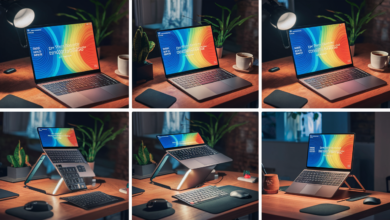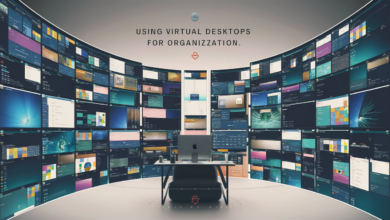Creating a Productive Home Office Setup

In today’s fast-paced world, working from home has become more than just a trend; it’s a necessity for many. As the lines between personal and professional life blur, creating a productive home office setup is essential to your success. A well-designed workspace not only boosts your efficiency but also enhances focus and creativity.
Imagine stepping into an area that inspires you—a sanctuary where ideas flow freely and distractions fade away. With the right elements in place, you can transform any corner of your home into an inviting work environment tailored to meet your needs. Let’s dive into how to make this vision a reality!
Assessing Your Space and Needs
Assessing your space is the first step in creating a productive home office setup. Take a good look around and identify areas that can be transformed into an efficient workspace. Whether it’s a corner of your living room or an entire spare room, understanding the dimensions will guide your decisions.
Next, consider your specific needs. Think about what tasks you’ll be performing daily. Are you often on video calls? A quieter nook may be ideal for you. Do you need ample storage for documents or supplies? Factor this into your layout.
Additionally, evaluate lighting conditions and proximity to power outlets. Natural light can boost mood and productivity, while easy access to plugs keeps devices charged without hassle.
By thoughtfully assessing both space and personal requirements, you’re laying the groundwork for a successful setup tailored just for you.
Essential Elements for a Productive Home Office
A productive home office starts with the right essentials. First, invest in a high-quality desk and chair. Comfort is key since you’ll be spending long hours at your workstation.
Next, good lighting can dramatically enhance your productivity. Natural light is ideal, but if that’s not an option, consider adjustable desk lamps to reduce eye strain.
Don’t overlook storage solutions. Shelves and filing cabinets help keep clutter at bay while ensuring that everything is easily accessible.
Also, think about ergonomics. Position your screen at eye level to prevent neck pain and place your keyboard within easy reach for optimal typing posture.
Incorporate personal touches like plants or artwork. These elements can boost creativity and make the space feel more inviting without becoming distracting.
Tips for Setting Up Your Desk and Workstation
Choosing the right desk is crucial. Aim for a height that allows your elbows to be at a comfortable 90-degree angle while typing.
Invest in an ergonomic chair to support your back during long hours. Your comfort should never be compromised.
Position your monitor at eye level to reduce strain on your neck. This small adjustment can make a significant difference.
Keep essential items within arm’s reach. Organize pens, notebooks, and other supplies in desk organizers or drawers.
Consider adding some personal touches like plants or artwork. These elements can boost creativity and enhance focus.
Lighting also plays a vital role; opt for natural light when possible, complemented by adjustable lamps for evening work sessions.
Declutter often—less mess leads to less stress as you tackle daily tasks efficiently.
Organizing Your Supplies and Files
A clutter-free workspace is essential for productivity. Start by assessing what supplies you really need. Keep only the essentials on your desk to minimize distractions.
Use storage solutions like drawer organizers or desktop trays. Clear bins can help categorize items such as pens, paper clips, and sticky notes. Label everything for easy access.
Digital files should also be neat. Create a well-structured folder system on your computer. Use descriptive names so you won’t waste time searching later.
Regularly declutter both physical and digital spaces. Set aside time each week to tidy up, ensuring that nothing piles up over time.
Consider using cloud storage solutions for important documents too. This not only keeps them organized but also provides easy access across devices.
An organized setup allows you to focus better and accomplish tasks more efficiently without unnecessary interruptions or stress.
Creating a Comfortable and Inspiring Atmosphere
Creating a comfortable and inspiring atmosphere in your home office is essential for productivity. Start by choosing colors that stimulate creativity. Soft blues and greens can promote calmness, while brighter shades like yellow can energize.
Lighting plays a critical role too. Natural light boosts mood, so position your desk near windows if possible. For evenings or cloudy days, invest in adjustable task lighting to reduce eye strain without sacrificing ambiance.
Incorporate personal touches to make the space feel uniquely yours. Hang artwork that inspires you or display photographs of loved ones. Plants add life to any environment; they improve air quality and enhance overall well-being.
Consider adding cozy elements like an ergonomic chair or plush throw blankets to create warmth. These details help transform a functional workspace into an inviting retreat where ideas flourish effortlessly.
Utilizing Technology for Efficiency
Technology plays a crucial role in optimizing your home office setup. Embracing the right tools can significantly enhance your efficiency.
Start with productivity software. Tools like Trello or Asana help you keep track of tasks and deadlines effortlessly. These platforms offer visual organization, making it easier to prioritize your workload.
Consider communication tools as well. Apps like Slack or Microsoft Teams streamline collaboration with colleagues, allowing for quick updates and project discussions without the need for endless emails.
Investing in ergonomic accessories is another smart move. A standing desk converter or an adjustable chair can improve comfort during long hours of work, reducing fatigue and distractions.
Don’t overlook automation. Using services like Zapier can minimize repetitive tasks by connecting different apps to handle them automatically. This allows you more time to focus on what truly matters in your workday.
Maintaining a Healthy Work-Life Balance
Maintaining a healthy work-life balance is essential for long-term productivity. When working from home, boundaries can blur easily. Establish clear hours for your workday and stick to them.
Take regular breaks throughout the day. Short walks or quick stretches can rejuvenate your mind and body, preventing burnout. Consider setting specific times for lunch away from your desk.
Engage in hobbies outside of work hours. Whether it’s reading, gardening, or cooking, these activities provide necessary mental shifts that recharge you.
It’s also important to communicate with family members about your schedule. This helps minimize interruptions during focused work time.
Be mindful of technology use after hours. Limit checking emails or messages once you’ve clocked out to maintain that boundary between professional and personal life.
Common Mistakes to Avoid in Home Office Setup
One of the biggest pitfalls is neglecting ergonomics. A poorly positioned chair or desk can lead to discomfort and decreased productivity. Invest in a good chair and set your screen at eye level.
Another mistake is clutter. A messy workspace creates distractions that hinder focus. Keep only essential items on your desk, storing others out of sight.
Lighting often goes overlooked too. Poor lighting can strain your eyes and drain energy levels. Aim for natural light if possible, supplemented by adjustable lamps to create an inviting atmosphere.
Many also forget about sound control. Noise can disrupt concentration significantly. Consider noise-canceling headphones or soft background music to enhance focus.
Don’t underestimate the impact of personalization. An uninspired space lacks motivation. Add personal touches like art or plants to foster creativity and make it feel truly yours.
Conclusion: Finding Success
Creating a productive home office setup is not just about placing a desk in the corner of your living room. It involves thoughtful planning, organization, and consideration for your personal workflow. By assessing your space and understanding your needs, you can tailor an environment that boosts focus and creativity.
Essential elements such as ergonomic furniture and adequate lighting play crucial roles in enhancing comfort while you work. Setting up your workstation thoughtfully can minimize distractions and optimize efficiency. Organizing supplies ensures everything is at arm’s reach when needed, reducing time wasted on searching for items.
A comfortable atmosphere filled with inspiring decor can serve as motivation during long work hours. Technology also has its part to play; utilizing the right tools can streamline tasks and improve productivity significantly.
Maintaining a healthy balance between work life and personal life is vital in this setting too. Avoiding common mistakes—like clutter or poor ergonomics—can set the stage for success.
With intention behind each choice made within your home office, achieving productivity becomes more attainable than ever before. Embrace this journey to create a workspace that reflects both professionalism and personalization, leading to greater achievements in all aspects of remote work.



